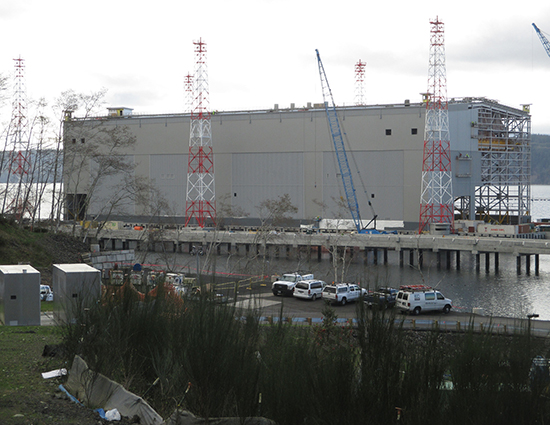|
Subscribe / Renew |
|
|
Contact Us |
|
| ► Subscribe to our Free Weekly Newsletter | |
| home | Welcome, sign in or click here to subscribe. | login |
Architecture & Engineering
| |
 |
January 23, 2017
Best in state: Gold award
Complexity
BergerABAM

Project: P-990 explosives-handling wharf No. 2
Client: Naval Facilities Engineering Command Northwest
Naval Base Kitsap, where the Naval Facilities Engineering Command Northwest is located, is the third-largest Navy base in the U.S. and is the command for the Navy’s fleet in the Pacific Northwest.
It features one of the Navy’s four nuclear shipyards, one of two strategic nuclear weapons facilities, the only West Coast dry dock capable of handling a Nimitz-class aircraft carrier and the Navy’s largest fuel depot. One key component was missing, though: an explosives-handling wharf to serve the Trident submarine, a project that was not only extremely complex but that also required an elevated level of security.
BergerABAM was the prime design engineering consultant and the engineer of record.
The project, which consisted of 226,900 square feet of pile-supported, over-water construction, included upland vehicular access and supporting utilities, approach trestles, the main wharf plus a warping wharf (a long narrow wharf extension used to position submarines prior to their moving into the operations area). The project also included a steel-framed, high-bay wharf cover with two 120-ton overhead bridge cranes, a multistory support building, on-wharf utilities and six lightning-protection towers.
The facility is situated in a seismically active area in deep water. It is positioned offshore to reduce the effect on the close-in habitat of Hood Canal. Only a slender trestle crosses the intertidal zone, keeping the main portion of the pier and its associated piling and overwater shading in deeper water to keep the shoreline open for fish passage and eelgrass beds.
In fact, the existing shoreline is maintained in a nearly undeveloped state, creating a cultural and economic resource of shellfish harvesting for the local Indian tribes. Even stormwater from the trestles and warping wharf is captured and conveyed to on-site water-quality catch basins where it is treated before being discharged.
For construction, instead of implementing the traditional cost-prohibitive and inefficient batter-pile systems, BergerABAM designed an innovative combination of steel plumb piles in bending and lead rubber bearings (LRBs) mounted on cast-in-place concrete pile caps supported on piles. This design stabilized the LRBs and pile-to-deck connections, allowing the wharf cover, plumb piles and wharf LRB dolphin piles to remain elastic during a seismic event, effectively providing base isolation for the wharf and wharf cover and reducing lateral load demands in these structures
The design also included precast pile cap and deck elements fabricated off-site at concrete plants where quality of materials and fabrication could be better controlled. The project incorporates the use of composite submarine “camels” — an advanced fiber-reinforced polymer composite material that provides improved corrosion resistance, and reduced maintenance and overall life-cycle costs.
“This project is extremely important to the mission of the Navy and to our national security, and you can be proud of the results of your efforts in meeting our needs,” David Gibson, a Navy project manager, wrote to the BergerABAM team.
Other Stories:
- National finalist: Platinum award
Environmental design
Magnusson Klemencic Associates - Best in state: Gold award
Complexity
Wood Harbinger - Best in state: Gold award
Social, economic and sustainable design
Landau Associates - Best in state: Gold award
Future value to engineering profession
DLR Group - Best in state: Gold award
Unique or innovative applications
Otak - National finalist: Gold award
Transportation
McMillen Jacobs Associates - National finalist: Gold award
Water resources
Shannon & Wilson - National finalist: Gold award
Waste and stormwater
Brown and Caldwell - National finalist: Gold award
Structural systems
HDR Engineering - National finalist: Gold award
Structural systems
COWI North America - National finalist: Gold award
Studies, research and consulting
WSP Parsons Brinckerhoff/EnviroIssues - Best in state: Gold award
Successful fulfillment of client/owner needs
Welch Comer Engineers


